How to start Growth Hacking? Hypotheses and team
Discover the secrets of rapid business growth from a growth marketing expert. What people to hire, how to manage a team, launch experiments, what tools to use, and a list of proven examples to inspire you.

Part 1: Guide to growth marketing explained by a growth hacker
Part 2: Growth hacking hypotheses and team
Part 3: Guide to hacking your product led growth marketing
Part 4: 3 rules and 5 must-have roles when building growth marketing team
Part 5: How to produce growth hypotheses
Part 6: Your growth marketing strategy template, guide, and examples
Part 10: A secret collection of growth marketing tools
Part 12: 25 Growth Marketing Books
Look at the rising line in the graphic. That is the story of “Growth Hacking” popularity over time. Or the last 15 years, to be exact.
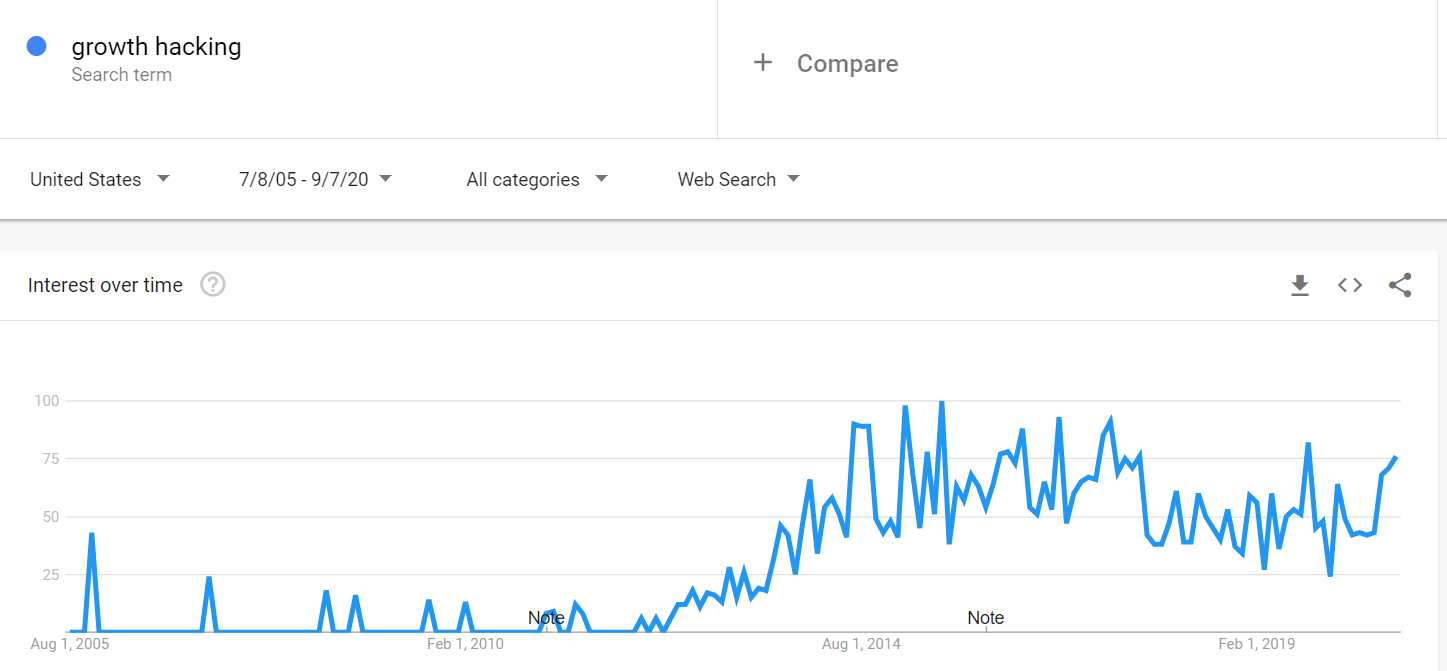
Sponsored by everyone who wants a company cheap and rapid success, this graphic presents growth hacking as a real trend.
Does it a hoax or a perfect strategy for the 21st century? Facebook’s ridiculous improvement rates up to 70 billion USD prove the second. But how? By crafting and testing the hypothesis.
What growth hacking is, who found it, how to find the ideas that turns your product into a market leader, and more you’ll read in this article.
What’s “Growth Hacking”? History and definition
“Growth Hacking” is often explained in the context of growing something (usually a business) at an exponential rate by manipulating its vital elements.
The problem is that a lot of users misunderstand this concept.
For instance, many companies try to hack their business development by inflating their sales plans and advertising budgets. Pretty soon, they’ve blown a huge chunk of their budget (sometimes all of it), but the result they expected never materializes.
Why?

Andrew Chen — an authority on startups, product metrics framework KPIs, and network effects, whose writings have been featured and quoted in The New York Times, Fortune — believes that after a time, channels exhaust themselves and cease to be effective. Additionally, many of them do not scale at all.
This is why putting your advertising on steroids will not lead to explosive growth.
Andrew Chen practically popularized the term “Growth Hacking” in a blog post titled, “Growth Hacker is the new VP Marketing”, so he’s someone you might want to listen to.
Turn your buttons orange and you’ll get a +5% the next day. However, sometimes they are extremely powerful and make the company
But he was far not the first person who used it.
Thanks! Here’s your copy of 100 growth ideas
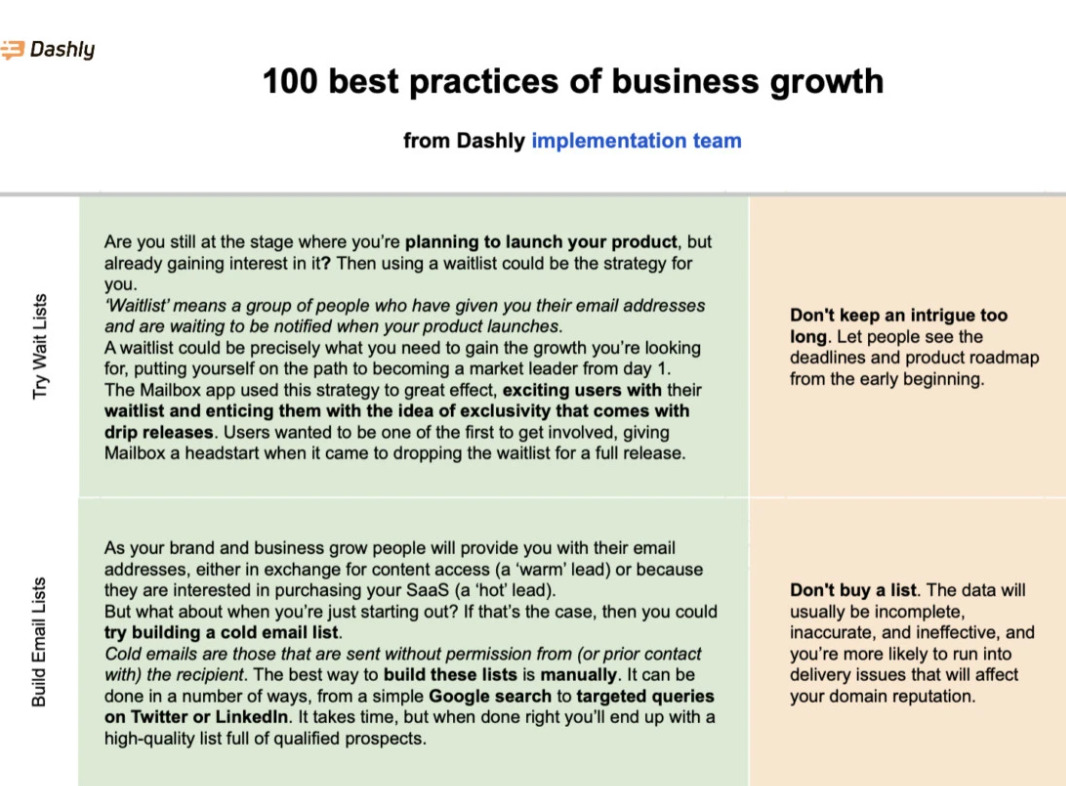
The first growth hacking expert: The origin of the growth hacker term
Sean Ellis coined it 10 years ago. This technique came from the name of the vacancy he placed looking for a successor for himself at PayPal. This person had to be more than just a marketer but someone who’s keen at marketing and tech, knows a product and data with a focus on sustainable development.
Used among Silicon Valley startups, it is a workable approach for a business of any size. But still, for startups, it’s a shortcut to win the competitive race with big companies. When the last have rich budget and resources, small companies look for alternative ways to market their product.
Does it define growth hacking? Just an alternative way to market?
There’s also another term that is often associated with “Growth Hacking” in marketing-speak — “Hypothesis Testing Pipeline”.
Big name, but fairly self-explanatory.
If you ask 10 people about what growth hacking is, you’ll get 10 different answers.
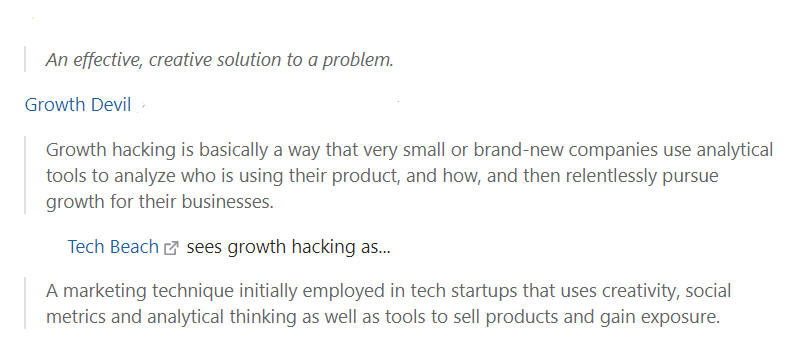
We’ve analyzed its top 10 explanations from the web and came to the next definition:
Growth hacking is a data-driven methodology that uses traditional marketing techniques for testing new hypotheses of product development.
Basically, it’s about the process of generating and testing hacks that will lead to a number of product users growth.
For instance, there was a time when the “hack” of having a referral program where you “Invite a Friend and Get a Bonus”, or content marketing, brought companies growth of up to $20 million in revenue.
Growth hacking is a systematic and ongoing test of hypotheses with the purpose of company growth.
Growth Hacking means “cracking” the growth of a company or a startup. It happens as a result of many initiatives, primarily marketing. The word “hack” is more of a colloquial term in this case.
Read also: Your Growth Marketing Strategy Template with guide and examples
Is the growth hacker a pro version of a marketer?
Growth hacking won’t replace traditional marketing, they are just different. When the last has a certain list of tasks to build company awareness, bring leads, etc., the only religion these experts profess is company growth. Growing this north star metric, they can ignore everything to achieve and hack it.
But still, the growth hacker funnel version is way bigger than marketer’s one:
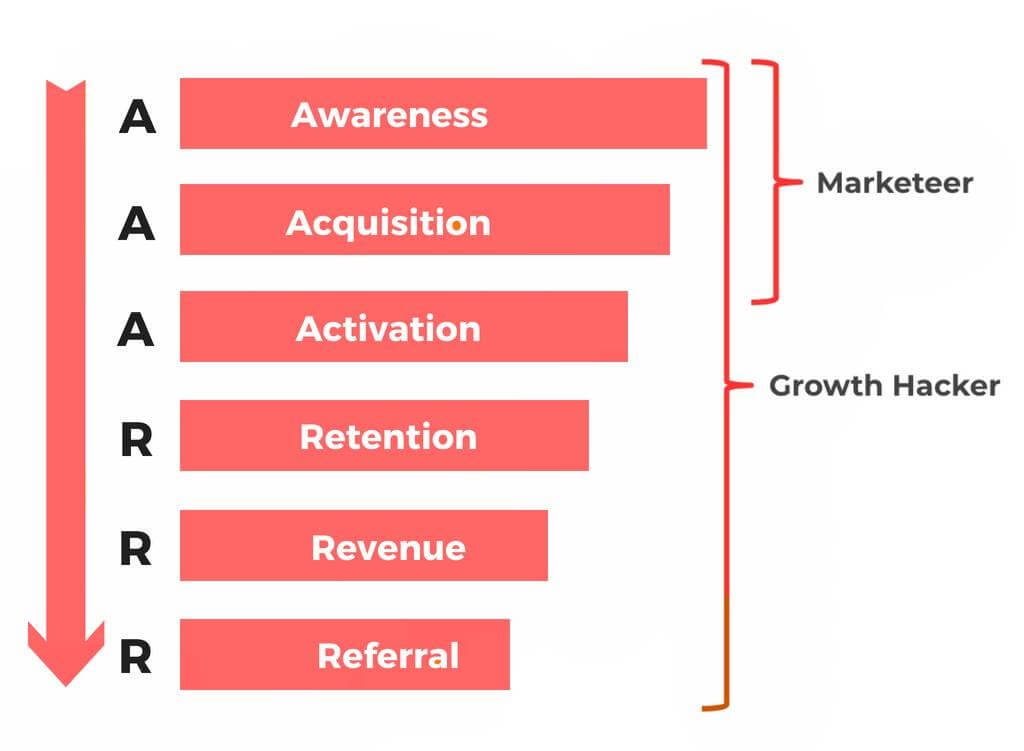
The list of funnel elements on how to hack the business growth vs. elements of the marketing funnel
- Growth hacker covers 5 phases with the only goal to grow revenue.
- Marketer efforts are aimed at brand awareness, gaining traffic, and converting it to leads.
Read also: Growth marketing vs performance marketing.
In fact, they look for an IS — smart way to leverage growth hacking. And in this article, we’ll be telling you how to growth-hack your business at a sensible pace, so that you get maximum growth without burning out.
Let’s start with a dose of inspiration.
Why hypothesis testing is vital to hacking your product growth
Well, the Importance of hypothesis-based testing in growth hacking is FUNDAMENTAL. Let me tell you why your business need to try it this year:
- Time and Cost Efficiency: Hypothesis-based testing helps to identify key growth areas and prioritize strategies that will yield quantifiable growth. By keeping an organized list of tested hypotheses, the growth marketing team can avoid wasting time and resources on tactics that don’t work.
- Data-Driven Results: Hypothesis-based testing relies on data to generate insights and make informed decisions. This approach ensures that growth hacking strategies are based on empirical evidence rather than assumptions and intuition.
- Risk Mitigation: Hypothesis-based testing also helps to mitigate risks associated with untested strategies. Rather than testing several unproven tactics simultaneously, growth hackers can test one hypothesis at a time, analyze results, and then adjust their approach accordingly.
- Continuous Improvement: Testing hypotheses regularly allows the growth hacking team to continually improve their approach and refine their strategies. They can identify and focus on areas with the most potential for growth and adjust their tactics accordingly.
- Competitive Advantage: By consistently testing and optimizing hypotheses, growth hackers can gain a competitive advantage over competitors who rely on outdated or untested strategies. A hypothesis-based approach helps to stay ahead of the curve and consistently generate growth for the business.
Examples of famous business growth hacks
Think of a company that EVERYBODY knows. Can you think of a couple more?
While everyone knows these businesses, they were once small startups with zero users and no revenue. But now, they now have multimillion-dollar revenues and a massive customer led growth. And they’ve achieved that by hacking their growth like crazy.
Dollar Shave video marketing
We constantly emphasize the effectiveness of video marketing, and one of the most renowned instances of growth hacking serves as evidence of this fact.
Dollar Shave Club harnessed the power of video ads to promote its monthly delivery service for razor blades, offered at the low price of $1. The video content swiftly went viral, garnering 19 million views and establishing the company as a widely recognized brand. You can view this video, which has amassed over 25 million views from potential users to date, below:
Two years after launch, Dollar Shave Club had made more than $20 million in revenue, says Business Insider. A year later, it tripled that figure.
Airbnb’s customer base growth hack
This is the first company Andrew Chen mentioned in terms of rapid growth because of the excellent growth hacking. Airbnb had neither users nor a reputation for being a reliable service for finding and renting housing. They needed to build a customer base quickly and establish themselves in the market.
To do this, they provided users with an opportunity — besides publishing on Airbnb, they could quickly and easily post their listings on Craigslist, an electronic classifieds site that was very popular at the time. So they got access to a huge database of their target audience.
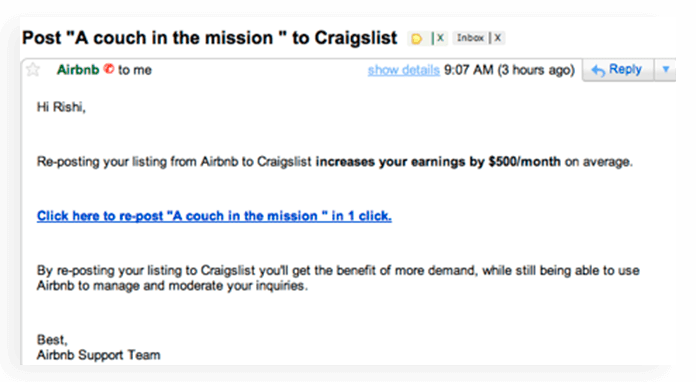
So what did they do:
- Asked their users for cross-posting on Craigslist with a link back to the Airbnb profile.
- Encouraged Craigslist’s hosts to Airbnb sign up.
Airbnb’s growth hack: Find your target audience on the web and leverage to get their attention. And don’t forget about the value of your business offer.
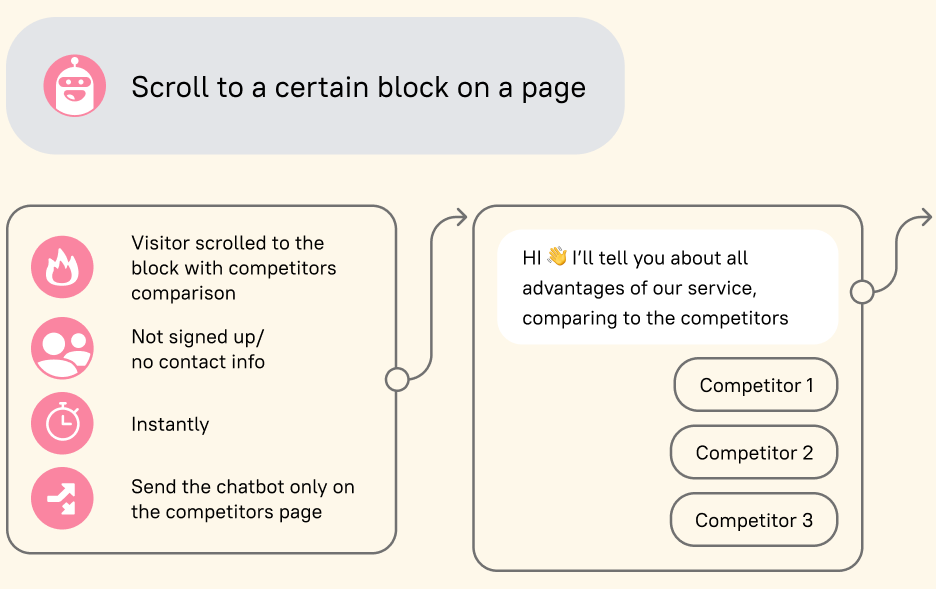
Get your free example of growth marketing playbook with 40+ templates for successful experiments
Hotmail email marketing growth hack
Don’t overlook the influence of an email signature. Another tactic on our list is surprisingly simple.
Hotmail (currently known as Outlook.com) attached a signature line to all of their outgoing emails content, which encouraged email receivers to sign up for a free account. This seemingly minor addition was sufficient to fuel a rapid increase in Hotmail’s users base to 12 million individuals (approximately 20% of the email market at that time) within just 18 months.

Instagram experiments
Instagram, which is now owned by Facebook and boasts over 800 million users, had a much humbler beginning. According to early adopters, Instagram’s triumph can be credited to the following hacks:
- Offering the desired user experience in new platform features.
- Concentrating on user experience and prioritizing ease of use.
- Encouraging individuals to sample the product before its release, cultivating a group of enthusiastic supporters.
Instagram recorded 10,000 users within one hour of its launch and has continued to grow ever since.

Gmail growth hacking
Gmail utilized an invite-only experience platform upon launch to generate growth, which proved to be successful. The fear of missing out (FOMO) is a potent marketing strategy, and if people are eager for your product, they’ll react positively to this approach.
Gmail’s appeal during its initial release lay in its exceptional email management and search capabilities, offering features that are now commonplace in email applications. The invite-only model was so triumphant that Gmail invitations were even sold on eBay. However, employing this type of digital experience necessitates great care. Google repeated this approach with other products that ultimately flopped, such as Buzz, Wave, and the scarcely recognizable by users Google+ platform.
The reason for this failure is that this digital approach works best in open settings, where tools and communities are available to everyone. In Gmail’s platform case, users could still send emails to non-Gmail users, so the exclusive invites were effective. However, in the case of closed social networks like Buzz or Google+ software, the absence of an active community rendered the software virtually unusable, thus limiting invitations backfired.

Dropbox’s growth gamification
Dropbox proposed a hypothesis to gamify referral programs: if a user invited a friend to the service, they would each get 500 MB.
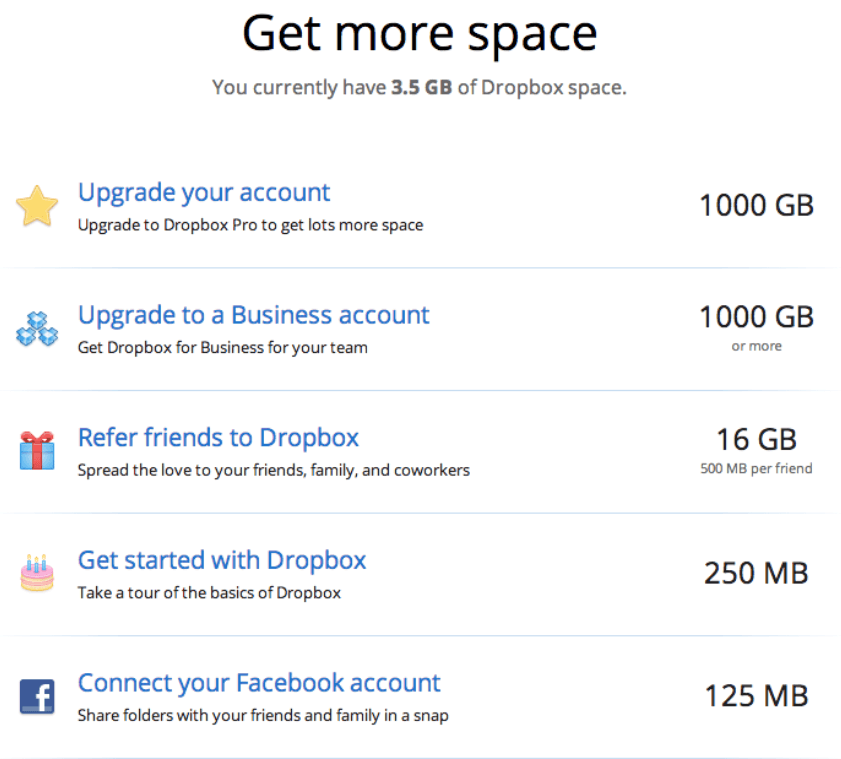
This is the kind of strategy that can drastically boost the number of new users. Additionally, sharing the link is as easy as making two clicks, which makes the potential for business growth even bigger.
This little strategy hack boosted Dropbox’s registrations by 60%. The hypothesis was confirmed, and now we all know about Dropbox.
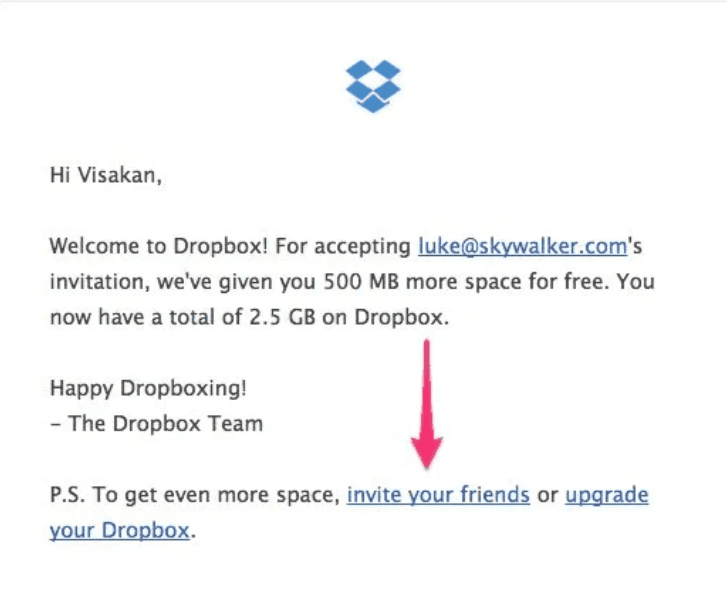
Dropbox’s growth hack: The key to user engagement is gamification. But the classical referral program doesn’t work, double-sided one is the best. Offering something to the users don’t forget to welcome those who they invite.
Facebook mentions grow hack
Facebook example tells how it got over 2 billion users. They achieved such numbers with the help of their own hacks machine.

One of the hypotheses they tested was an email newsletter with a notification that the user had been mentioned in a post or tagged in a photo. This has helped increase the number of returns to accounts.
But this strategy has turned into a double-edged sword. Now, it’s come to a point where you’re flooded with notifications just because a friend of yours posted on someone else’s wall. And that’s not what make a social network attractive. Instead, users are increasingly seeing it as a trick they don’t want to fall for.

Facebook’s growth hack: think over the channels to engage your target audience via the existing one.
Here are more examples of the marketing tactics your digital platform can make use of:
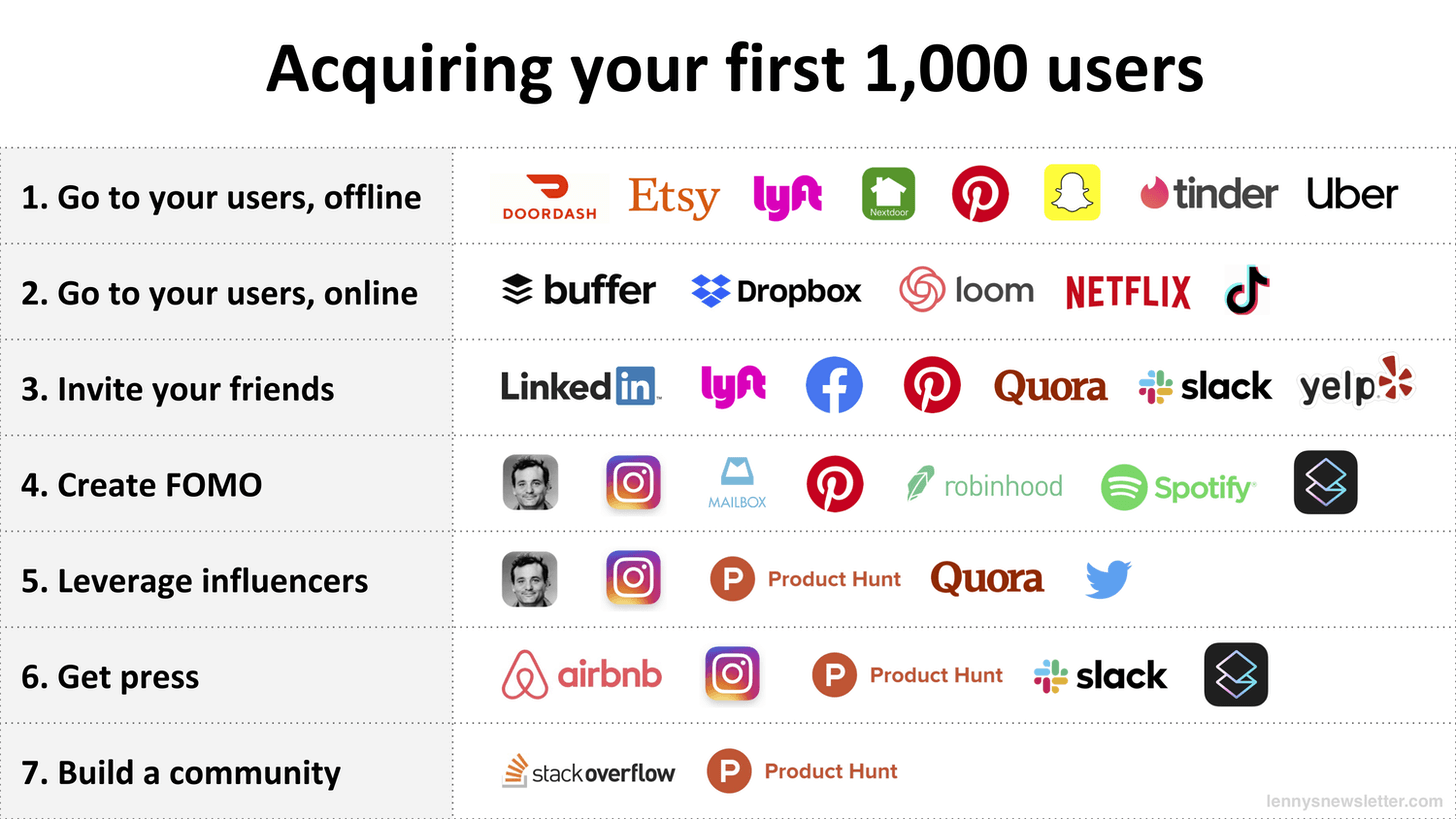
If you want more ideas and insights, choose a growth marketing newsletter to subscribe to!
Grow and Convert content growth hacking
The subsequent example in our growth hacking list highlights the importance of content. Grow and Convert acquired more than 32,000 users over five months without having to pay for website traffic. Here’s how they achieved it:
- Initially, they identified their target audience, which helped them develop content suitable for their demographic (creating buyer personas can aid in this task).
- They explored popular social platforms such as Google, Quora, Facebook, etc. to locate engaged communities in which their target audience participated.
- They solicited advice from their audience regarding their trusted sources for content ads.
- They integrated themselves into these target communities, engaged respectfully with existing content, and then shared their own content like landing page links or articles selectively and transparently.
Apart from newly acquired users, Grow and Convert became an integral part of a larger community, subsequently generating SEO benefits through inbound links from all the groups they participated in.
So now you’re probably wondering, “How can I use these insights to growth-hack my business?” Let’s find out.
How you can use growth hacking for your business

In our article, “Are you making any of these 7 funnel-killing mistakes?” we talked about the mistake of trying to reinvent the wheel. When it comes to business, mistakes can have very serious consequences, which is why learning from the successes and failures of others is crucial.
Here are some growth marketing tools to start testing ideas for your business development:
- Grow your email list by subscription form or pop-up on the website.
- A blog to test marketing efforts because everyone loves content.
- Build your own brand to build others.
- Create high-quality content on high-quality sites for reputation first and only then for linkbacks.
- Conduct growth marketing analytics to understand the data (content results, customer data, experience, etc.) you have.
Keeping this in mind, let’s see what we can learn from the achievements (and mistakes) of the companies we mentioned above.Sit tight, because we’re about to share with you some top-notch advice from Yuri Drogan, the Growth Hacking expert who guided the Dashly in its quest for growth hacking.
As explained earlier, Growth Hacking enables businesses to achieve exponential growth through the constant testing of hypotheses. “Exponential growth” refers to a kind of growth that is two, three, five, ten times what a business would normally expect to see.
How fast your business grows, depends directly on the number of hypotheses you test. The more you test, the more likely you are to achieve exponential growth.
Want more ideas for your growth strategy? We want to help! 👇
What does it mean to “test a hypothesis”?
Einstein was a pretty smart guy. And yet, when he was building his Theory of Relativity, he went about it in a very basic, methodical, and structured way.
- First, he formulated a hypothesis.
- Next, he ran a ton of tests over an extended period of time.
- Finally, through lots of experimentation, he arrived at a number of conclusions that contradicted the generally-accepted theory at the time.
- So he used his findings to build a new theory, based on the data he had gathered and the conclusions he had reached. And even after all these years, repeated tests continue to prove his theories.
So, a growth hacking hypothesis is an assumption that requires proof.
Growth hacking requires you to accept the fact that you know almost nothing about your users (unless you already have all data in hand, but most of us don’t). I know how painful this is, but once you’ve accepted it, it becomes much easier to generate and test hypothesis. Another thing you will need is the key metric, your Pole Star. So that when you have dozens of ideas and hypothesis, you could pick up the one that works on the Pole Star.
In the case of business growth hacking, this assumption is within the context of rapid growth. And the experiment is conducted in order to prove or refute the hypothesis.
- Hypothesis = Assumption requiring proof
- Experiment = Process of proving or refuting the hypothesis
Here’s a practical example: Let’s say we start with the hypothesis that we can increase sales by X by installing online chat on our site to communicate with our customers.
Next, we conduct the growth hacking tests by actually installing online chat and monitoring calls and sales. We notice that after we installed a chat, our sales actually increased, so our hypothesis is confirmed.
Read also: RevOps vs Sales Ops.
Never fully rely on your past experience. The channel that had hardly brought any result a few months ago may become your highest-converting channel now. Much like a Facebook ad may perform better after pausing it for a while. So keep testing. Because there is always a way to do it better.
The whole point of the growth hacking process is to come up with a lot of hypotheses, and test them rapidly.
The coolest hypotheses are always about the value of the product for users.
But first, collect the perfect toolset for your experiments with our list of the best growth hacking tools 👇
Thanks! Here’s your copy of 50 growth hacking tools
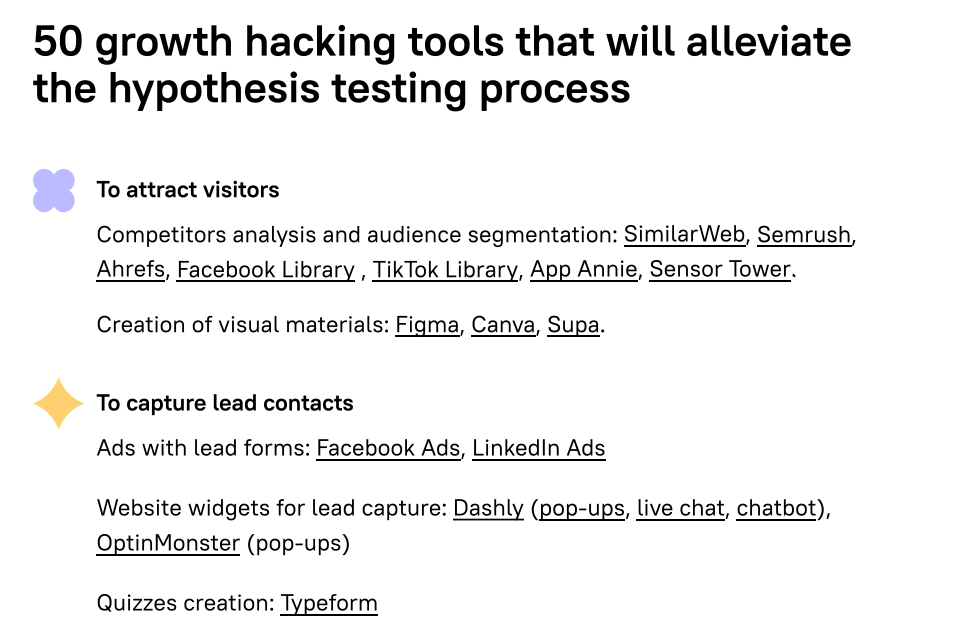
Why growth hackers test a lot of hypotheses
Here’s a scenario for you to consider.
You want to grow business fast, so you start testing hypotheses. You can probably test one hypothesis per week. There are 52 weeks in a year. If you take away holidays, and maybe a couple of weeks for sick leave, meetings, conferences, and so on, you’re left with around 42 working weeks a year. So that’s 42 hypotheses tested in one year, assuming we stick to the schedule of testing one per week.
That doesn’t sound too bad. But if you actually look at the numbers, you’ll find that only about one in ten hypotheses turn out to be true. So out of your 42 hypotheses in a year, you’re left with only 4 that you can work with.
Additionally, imagine that each of these hypotheses brings you a 3% growth. That’s works out to roughly 12% per year.
Not really what you’d consider “explosive growth”.
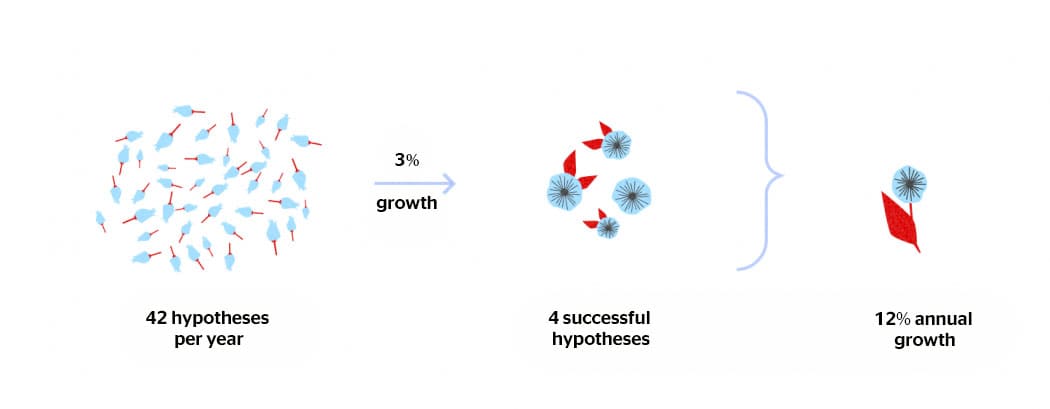
But try testing 300 hypotheses. That works out to around 30 successful hypotheses, contributing an expected average growth of 3% each, for a compound annual growth of over 142%.
Pretty impressive, don’t you think?
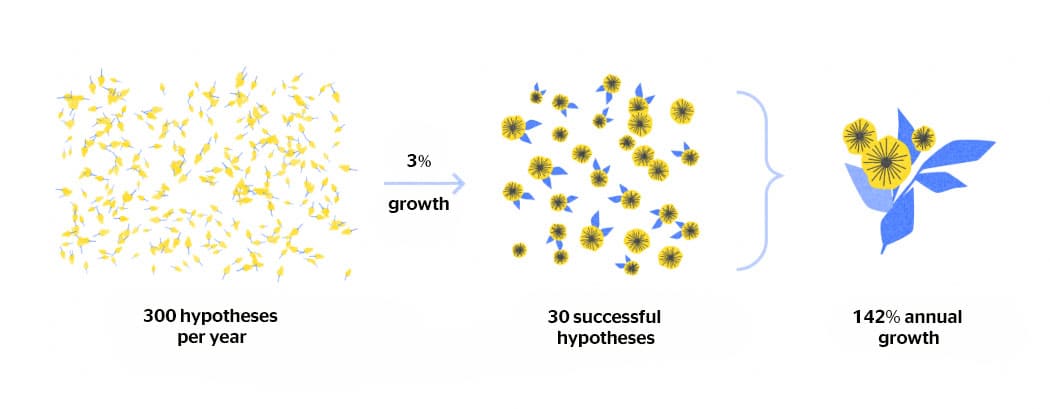
The number of tests per week is directly proportional to the growth rate of the company.
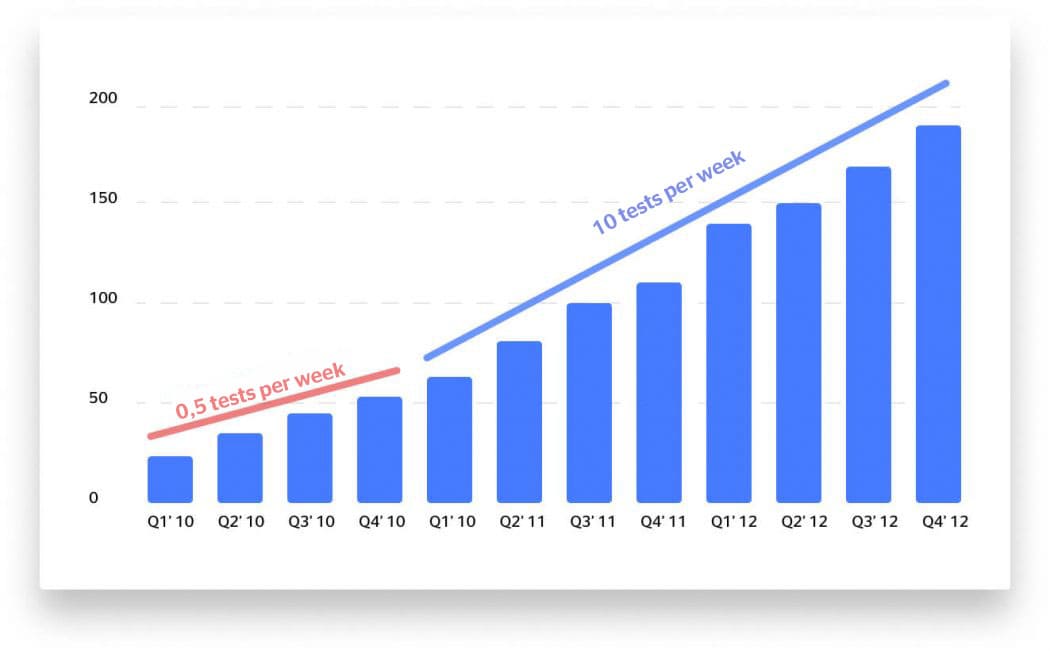
Of course, it’s not as simple as it sounds. To test five, ten, or one hundred hypotheses per week, you need a well-established testing process — a hypothesis generation engine, continuous experimentation, and analytics. So, your business needs a growth hacking plan.
How to start your own hypothesis pipeline
We’ve already agreed that the more testing you do, the higher your chances of getting explosive growth. To do that effectively, you’ll need a growth hacking team that will devote all of its time to generating, prioritizing, testing, and analyzing hypotheses.
But what does a growth hacker look like?
Andrew Chen believes that growth hackers are typically marketer/programmer hybrid. When you ask them the question, “How do I bring users to my product?” they will reply, “By A/B testing landing pages, virality hacks, and mailshots.”
18 business growth experts you should follow this year

What are Growth Loops? How It Can Scale Your Company

Product Led Growth Marketing: hack your product growth

Growth hackers rely on data and quantitative measurements. They draw conclusions exclusively on that basis. And these are the kind of growth-oriented people that you will need in your growth team.
The selection of the team itself should begin with the grower of the master — the person who will be responsible for team processes, plan sprints, and also manage the testing process.
The growth team needs not a leader, but a competently built process for testing hypotheses.
It is difficult to clearly define positions in the growth team. Full-stack specialists are highly valued because they can navigate the many tasks involved while hiring individual specialists for every aspect of the process is too expensive. You need people who can fulfill these roles:
- analytics;
- developer;
- a marketer who knows everything about channels and traffic;
- layout designer;
- designer, preferably a UX developer.
Growth hacking is the process of building something very quickly “from mud and stone” (as the old saying goes). Involving a dedicated designer at this point can only slow down the work, so there should be someone in the team who knows how to quickly cut landings, make buttons, and so on.
The primary goal of the business growth team is — you guessed it — growth, and its primary task is to quickly test quantitative hypotheses.
Now that you have a growth team, all that’s left is to build the process itself of generating ideas for practical growth hacking, testing hypotheses, and analyzing them further. And we’ll tell you how to do this in part two of this article.
Essential tools for growth hacking
Here are types of growth marketing services your may need:
- Analytics and data tracking platforms to monitor results,
- Customer relationship management (CRM) software,
- Email marketing tools like Dashly or Hubspot,
- A/B testing and optimization tools,
- PPC like Google Ads, Facebook Ads, etc.,
- Social media management tools,
- Content creation and marketing tools,
- User feedback and survey tools.
I described the detailed list of free and paid tools Dashly team uses for hypotheses testing in this article.
Thanks! Here’s your copy of 50 growth hacking tools

To sum up: tips for getting started with hypothesis testing
In summary, hypothesis testing is an essential part of growth hacking as it enables you to validate assumptions and make data-driven decisions. To get started with hypothesis testing, you should:
- start with a clear problem statement or question,
- gather data and conduct research,
- generate hypotheses,
- prioritize them based on impact and feasibility,
- create a test plan and timeline,
- implement tests,
- measure and analyze results,
- and constantly iterate and refine your hypotheses.
By following these tips, you’ll be able to generate and test hypotheses more efficiently and effectively and drive growth for your business.
FAQ on Growth Hacking
What does growth hacking mean?
It’s generating and testing hypotheses based on data and marketing channels to lead a company to new solutions and rapid growth.
Why is growth hacking important?
Using it, you can outsmart your competitors and gaining millions of clients and dollars in revenue ridiculously fast and cheap.
When to hire a growth hacker?
It’s better to look for a growth hacker when your product achieved market fit, has the potential to grow revenue with minimal cost, plain company processes. At this point, you should know the fundamentals of growth hacking and how to scale your team and fund growth.
How to growth hacking?
The step-by-step guidance on how to hack the business growth you’ll find in our next expert article “How to Ensure Continuous Growth Hacking”.
What does a growth hacker do?
Marketing growth hackers do 2 major buckets: planning and tests. Starting with a model for how a site grows, they try out hypotheses and deploy them as A/B tests. If it works, they test new ones, if not ― rethink the model of the 1st step because it might be broken.
How can I become a growth hacker?
First, you need skills at SMM, community management, database & SQL, analytics, direct and content marketing, conversion optimization, web development. Your next steps is described in the article from Dashly experts “How to Ensure Continuous Growth Hacking”.
What experts to follow?
- Andrew Chen, follow on Twitter.
- Rebecca Rosenfelt, Airbnb’s growth strategy expert.
- Brian Balfour, the startup sector expert. Follow on Twitter.
- Nir Eyal, Consultant, Public Speaker, Best-Selling Author. Follow on Twitter and LinkedIn.
- Alex Schultz on Twitter.
How Do I Start Growth Hacking Successfully?
The key to growth hacking is conducting experiments. Consistently try out fresh methods and determine which ones work best for your organization. Additionally, it’s critical to employ a data-focused approach. Monitor all actions taken and their impact on business success. This will allow you to recognize effective and ineffective strategies and adjust your tactics accordingly. Lastly, always consider ways to expand. Growth hacking involves discovering sustainable methods for rapidly growing your business. Once you discover a successful strategy, establish a plan to replicate it on a larger scale.
| This’s the update of the article that was published 15 January, 2020. |
Read also:
- 25 Growth Marketing Books to Skyrocket Success
- 22 SaaS growth hack Facebook tactics to boost your business
- Skyrocket your company revenue with a complete guide to RevOps Revenue Operations
- RevOps tech stack: guide to the best tools
- Revenue operations metrics: 10 metrics and KPIs to track your performance
- B2B growth marketing: accelerating business success
- Demand Generation vs Growth Marketing: Where to focus?
- Product led growth metrics: 13 key indicators for SaaS companies to track
- PLG tools: ultimate guide to the best instruments
- Benefits of Product led growth: 12 PLG benefits for your business
- Top 10 product led growth software your competitors use in 2023
- 10 product led growth companies that boost their development right now
- Sales led growth: what is it and why your business needs it
- Growth Product Manager: Charting new frontiers in product scaling
- 20 product led growth examples to inspire your team [expert edition]










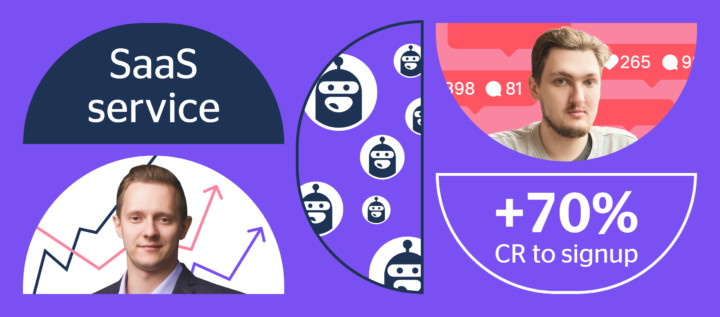

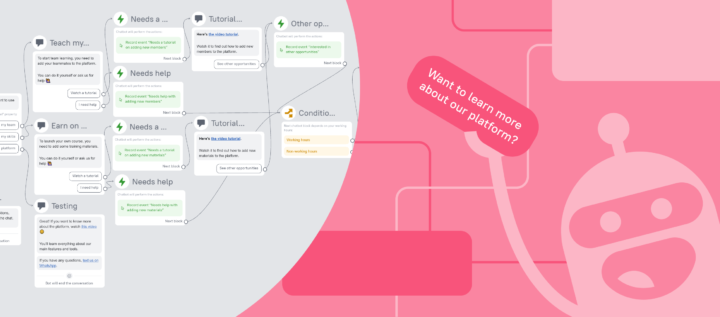

![What is growth hacking and how it works [explained by experts]](https://www.dashly.io/blog/wp-content/uploads/2023/04/What-is-growth-hacking-and-how-it-works-explained-by-experts-720x317.png)

